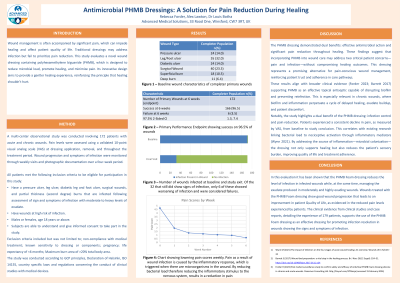Clinical Research
(CR-039) Antimicrobial PHMB Dressings: A Solution for Pain Reduction During Healing

Wound management is often accompanied by significant pain, which can impede healing and affect patient quality of life. Traditional dressings may address infection but fail to prioritize pain reduction. This study evaluates a novel wound dressing containing polyhexamethylene biguanide (PHMB), which is designed to reduce microbial load, promote healing, and minimize pain. Its innovative design aims to provide a gentler healing experience, reinforcing the principle that healing shouldn’t hurt.
Methods:
A multi-center observational study was conducted involving 184 patients with acute and chronic wounds. Pain levels were assessed using a validated 10-point visual analog scale (VAS) at dressing application, removal, and throughout the treatment period. Wound progression and symptoms of infection were monitored through weekly visits and photographic documentation over a four-week period.
Results:
Patients treated with the PHMB dressing reported significantly lower pain scores throughout healing (Start mean VAS: 4.6) compared to (exit mean VAS: 0.6; p < 0.0001). The results demonstrate that the PHMB dressing enables wound progression and providing a systematic approach to removing the barriers to healing. The mean total wound area (cm2) changed from 48.2cm2 at baseline to 11.7cm2, it was a change of -36.5 (95% CI of the mean [33.5,62.9] at baseline, [7.9, 15.6] at endpoint). The tissue types and wounds aetiologies showed improvement with a reduction in the percentages of necrotic and sloughy tissue in the wound bed and an increase in epithelial tissue. A reduction in the signs and symptoms of infection was also found.
Discussion:
The PHMB dressing demonstrated dual benefits: effective antimicrobial action and significant pain reduction throughout healing. These findings suggest that incorporating PHMB into wound care may address two critical patient concerns—pain and infection—without compromising healing outcomes. This dressing represents a promising alternative for pain-conscious wound management, reinforcing patient trust and adherence in care pathways.

.jpg)